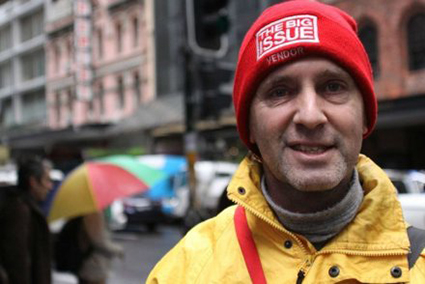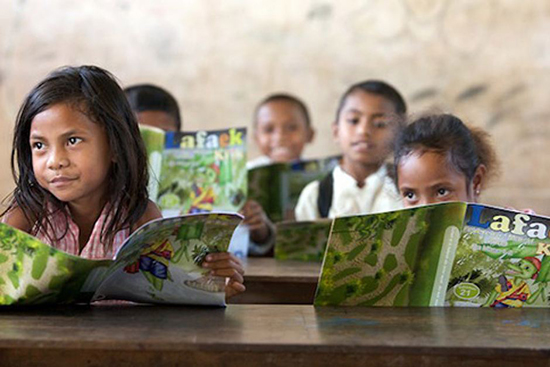
Christian Teo
SYDNEY (Radio Australia/Pacific Media Watch): Australia's Big Issue and Timor-Leste's Lafaek magazines are bucking global trends by focusing on social justice.
In a bygone era, the mention of magazines might have conjured images of ditzy cover models or shiny continental cars on impeccably trimmed lawns.
But times are changing.
Even as magazines struggle to stay relevant, a new vanguard of independent publications is carving their footprint in the world.
Magazine sales have plummeted by 11.5 percent since 2012, according to the Audited Media Association of Australia.
This alarming figure, however, does not faze Alan Attwood, editor of The Big Issue. Since leaving The Age 11 years ago, he has devoted himself to the fortnightly magazine.
The Big Issue's red and yellow-clad vendors sell copies on the streets, taking half of the cover price as income.
Homeless, unemployed
Many of them are homeless, unemployed or suffer from mental illness.
"At the end of the day, we are producing the magazine for them [vendors], not for me, not for the team that puts the magazine together," Attwood said.
"We're producing a product for the people who sell it. So if they say that we're going down the wrong direction, I have to listen."
This model has worked well. Attwood said the shop's estimated earnings of $30,000 a fortnight covered both operational costs and the wellbeing of its estimated 500 vendors.
Ironically, what appears to be keeping The Big Issue from becoming an artefact is its print format.
"In a weird kind of way as we're becoming more and more of a digital sort of marketplace, to be an old-fashioned print publication, I think is actually a good thing," Attwood said.
"It's an attractive thing. It's a bit like LPs, which are back bigger than ever."
What truly drives upward sales of The Big Issue is its flair for creating the unusual.
A quick glance around The Big Issue's office in Melbourne reveals a host of riveting covers, including a pop art treatment of Black Eyed Peas vocalist Will.i.am, and a Fame Of Thrones cover line for Peter Dinklage.
There is little to suggest that a host of humanitarian issues tackling anything from poverty to women's rights are contained within the archives of The Big Issue.
"The worst thing that can happen to us is that someone sees an edition on the street and thinks, 'I think I've seen that one', and if they haven't we've just missed a sale," Attwood said.
Learning across borders
Across the ocean, another magazine is also hoisting the banner for social justice.
Timor-Leste-based Lafaek was launched by CARE Australia in 2002 to buttress teaching resources in the region, where illiteracy rates are extremely high.
Eighteen percent of the adult population lacks a secondary education and just 1.4 percent has attended a tertiary institution.
Like The Big Issue, Lafaek is cause-driven - acting as both a children's magazine and curricular supplement.
Lafaek's project manager, Simplicio Barbosa, said the publication instructed teachers how to use materials to teach in the classroom.
"There are lesson plans, information about teaching methodologies and positive disciplines. It aims to help teachers improve their professionalism," he said.
Last month, Barbosa made a 17-hour flight to Melbourne to immerse in and learn from The Big Issue team.
Invaluable lessons
He believes that Lafaek can take invaluable lessons from The Big Issue in producing relevant and engaging content for teachers and students alike.
Around 80,000 copies of Lafaek have been distributed to households and schools across all 13 of East Timor's districts.
The undulating and mountainous topography of East Timor, however, makes travelling by car or public transport near impossible.
This means deliveries are often made on foot.
CARE Australia's Amelia Taylor said this passion would drive the magazine toward greater heights.
Looking to The Big Issue's successful model, she foresees a more financially independent Lafaek in the future.
New Zealand aid
Currently, New Zealand Aid is providing a $4.7 million grant over a four-year period to the magazine.
"I think The Big Issue is a really lovely comparison to Lafaek magazine," Taylor said.
"Both are deeply loved by their readership and really iconic titles.
"So I think it's really great for some of the Lafaek members to spend time with The Big Issue and learn about their processes.
"We're looking to the future to make it sustainable without the need for international assistance, which is the aim of all international development programmes."
At a time where many in media land are facing unprecedented uncertainty, it would appear that creativity and humility could lay the bedrock for a more sustainable and optimistic print media.
People like helping other people - and this has been articulated throughout history in the voices of ordinary people.
This appeal is not about to dissipate in a time where the individual is more readily heard than ever.
Moving forward it is this notion perhaps that will prove advantageous to a new generation of print dabblers, and the rise of the social justice editor.

This work is licensed under a Creative Commons Attribution-NonCommercial 3.0 New Zealand Licence.




